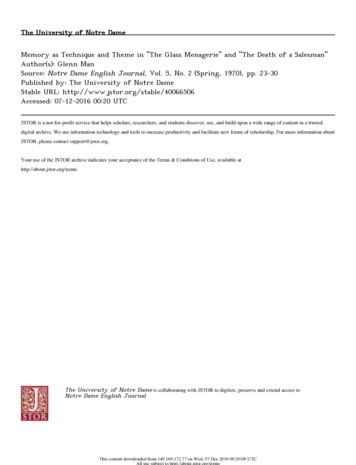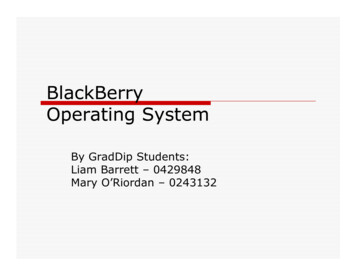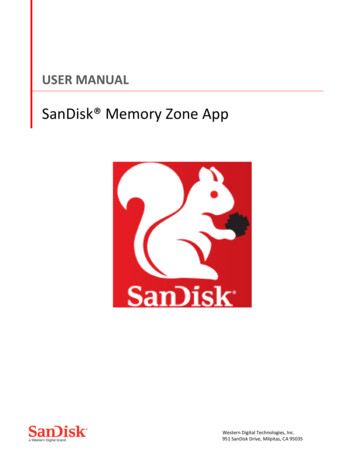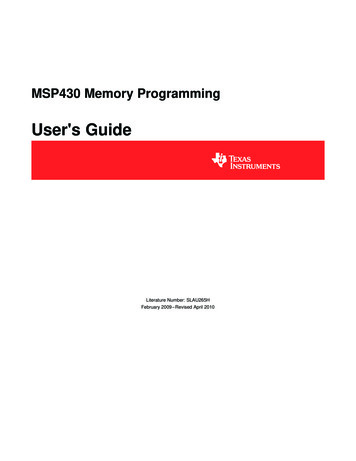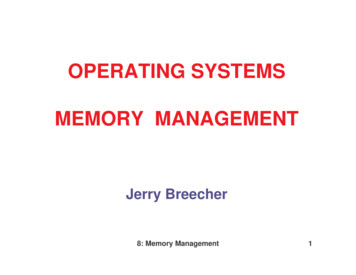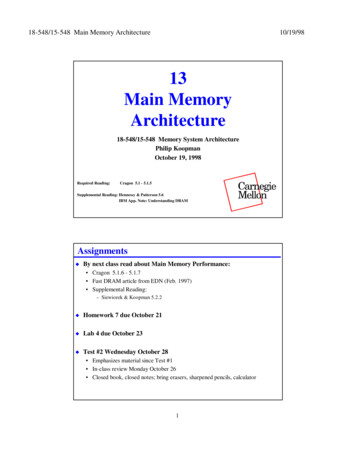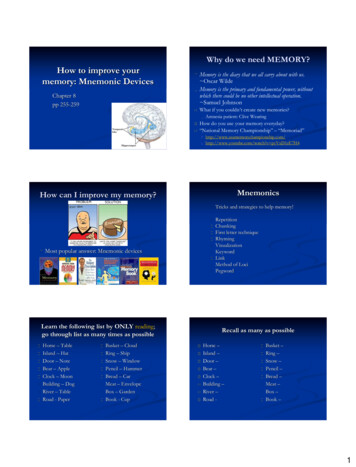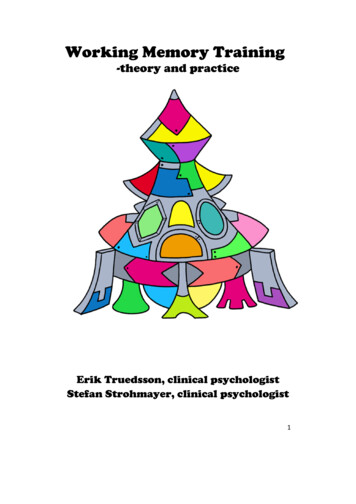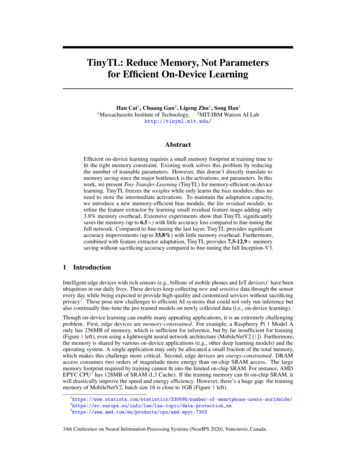
Transcription
TinyTL: Reduce Memory, Not Parametersfor Efficient On-Device Learning1Han Cai1 , Chuang Gan2 , Ligeng Zhu1 , Song Han1Massachusetts Institute of Technology, 2 MIT-IBM Watson AI Labhttp://tinyml.mit.edu/AbstractEfficient on-device learning requires a small memory footprint at training time tofit the tight memory constraint. Existing work solves this problem by reducingthe number of trainable parameters. However, this doesn’t directly translate tomemory saving since the major bottleneck is the activations, not parameters. In thiswork, we present Tiny-Transfer-Learning (TinyTL) for memory-efficient on-devicelearning. TinyTL freezes the weights while only learns the bias modules, thus noneed to store the intermediate activations. To maintain the adaptation capacity,we introduce a new memory-efficient bias module, the lite residual module, torefine the feature extractor by learning small residual feature maps adding only3.8% memory overhead. Extensive experiments show that TinyTL significantlysaves the memory (up to 6.5 ) with little accuracy loss compared to fine-tuning thefull network. Compared to fine-tuning the last layer, TinyTL provides significantaccuracy improvements (up to 33.8%) with little memory overhead. Furthermore,combined with feature extractor adaptation, TinyTL provides 7.5-12.9 memorysaving without sacrificing accuracy compared to fine-tuning the full Inception-V3.1IntroductionIntelligent edge devices with rich sensors (e.g., billions of mobile phones and IoT devices)1 have beenubiquitous in our daily lives. These devices keep collecting new and sensitive data through the sensorevery day while being expected to provide high-quality and customized services without sacrificingprivacy2 . These pose new challenges to efficient AI systems that could not only run inference butalso continually fine-tune the pre-trained models on newly collected data (i.e., on-device learning).Though on-device learning can enable many appealing applications, it is an extremely challengingproblem. First, edge devices are memory-constrained. For example, a Raspberry Pi 1 Model Aonly has 256MB of memory, which is sufficient for inference, but by far insufficient for training(Figure 1 left), even using a lightweight neural network architecture (MobileNetV2 [1]). Furthermore,the memory is shared by various on-device applications (e.g., other deep learning models) and theoperating system. A single application may only be allocated a small fraction of the total memory,which makes this challenge more critical. Second, edge devices are energy-constrained. DRAMaccess consumes two orders of magnitude more energy than on-chip SRAM access. The largememory footprint required by training cannot fit into the limited on-chip SRAM. For instance, AMDEPYC CPU3 has 128MB of SRAM (L3 Cache). If the training memory can fit on-chip SRAM, itwill drastically improve the speed and energy efficiency. However, there’s a huge gap: the trainingmemory of MobileNetV2, batch size 16 is close to 1GB (Figure 1 ropa.eu/info/law/law-topic/data-protection 02234th Conference on Neural Information Processing Systems (NeurIPS 2020), Vancouver, Canada.
Table 3Table 2ResNet-50SRAM AccessEnergyTraining, bs 820Activation (MB)890.821000MbV2Memory Footprint (MB)Param The main bottleneck does not improve much.1.1x750120013.9x larger500250800Raspberry Pi 1 DRAM400Activation is themain bottleneck,not parameters.AMD EPYC CPU SRAM (L3 Cache)0InferenceBatch Size 14.3x0TrainingBatch Size 16Param (MB)Activation (MB)Figure 1: Left: The memory footprint required by training easily exceeds the limit of edge devices.Right: Memory cost comparison between ResNet-50 and MobileNetV2-1.4 under batch size 16.Recent advances in efficient model design only reduce the size of parameters, but the activation size,which is the main bottleneck for training, does not improve much.There is plenty of efficient inference techniques that reduce the number of trainable parameters andthe computation FLOPs [1, 2, 3, 4, 5, 6, 7, 8, 9, 10], however, parameter-efficient or FLOPs-efficienttechniques do not directly save the training memory. It is the activation that bottlenecks the trainingmemory, not the parameters. For example, Figure 1 (right) compares ResNet-50 and MobileNetV21.4. In terms of parameter size, MobileNetV2-1.4 is 4.3 smaller than ResNet-50. However, fortraining activation size, MobileNetV2-1.4 is almost the same as ResNet-50 (only 1.1 smaller),leading to little memory reduction. It is essential to reduce the size of intermediate activationsrequired by back-propagation, which is the key memory bottleneck for efficient on-device training.In this paper, we propose Tiny-Transfer-Learning (TinyTL)to address these challenges. By analyzing1the memory footprint during the backward pass, we notice that the intermediate activations (themain bottleneck) are only involved in updating the weights, not the biases (Eq. 2). Inspired bythis finding, we propose to freeze the weights of the pre-trained feature extractor and only updatethe biases to reduce the memory footprint (Figure 2b). To compensate for the capacity loss, weintroduce a memory-efficient bias module, called lite residual module, which improves the modelcapacity by refining the intermediate feature maps of the feature extractor (Figure 2c). Meanwhile,we aggressively shrink the resolution and width of the lite residual module to have a small memoryoverhead (only 3.8%). Extensive experiments on 9 image classification datasets with the samepre-trained model (ProxylessNAS-Mobile [11]) demonstrate the effectiveness of TinyTL comparedto previous transfer learning methods. Further, combined with a pre-trained once-for-all network [10]to select a specialized sub-network as the feature extractor for each transfer dataset (i.e., featureextractor adaptation), TinyTL can achieve the same level (or even higher) accuracy compared tofine-tuning the full Inception-V3 while reducing the training memory footprint by up to 12.9 . Ourcontributions can be summarized as follows: We propose TinyTL, a novel transfer learning method to reduce the training memory footprint byan order of magnitude for efficient on-device learning. We systematically analyze the memory of training and find the bottleneck comes from updatingthe weights, not biases (assume ReLU activation). We also introduce the lite residual module, amemory-efficient bias module to improve the model capacity with little memory overhead. Extensive experiments on transfer learning tasks show that our method is highly memory-efficientand effective. It reduces the training memory footprint by up to 12.9 without sacrificing accuracy.2Related WorkEfficient Inference Techniques. Improving the inference efficiency of deep neural networks onresource-constrained edge devices has recently drawn extensive attention. Starting from [4, 5, 12, 13,14], one line of research focuses on compressing pre-trained neural networks, including i) networkpruning that removes less-important units [4, 15] or channels [16, 17]; ii) network quantization that2
reduces the bitwidth of parameters [5, 18] or activations [19, 20]. However, these techniques cannothandle the training phase, as they rely on a well-trained model on the target task as the starting point.Another line of research focuses on lightweight neural architectures by either manual design [1, 2,3, 21, 22] or neural architecture search [6, 8, 11, 23]. These lightweight neural networks providehighly competitive accuracy [10, 24] while significantly improving inference efficiency. However,concerning the training memory efficiency, key bottlenecks are not solved: the training memory isdominated by activations, not parameters (Figure 1).There are also some non-deep learning methods [25, 26, 27] that are designed for efficient inferenceon edge devices. These methods are suitable for handling simple tasks like MNIST. However, formore complicated tasks, we still need the representation capacity of deep neural networks.Memory Footprint Reduction. Researchers have been seeking ways to reduce the training memoryfootprint. One typical approach is to re-compute discarded activations during backward [28, 29].This approach reduces memory usage at the cost of a large computation overhead. Thus it is notpreferred for edge devices. Layer-wise training [30] can also reduce the memory footprint comparedto end-to-end training. However, it cannot achieve the same level of accuracy as end-to-end training.Another representative approach is through activation pruning [31], which builds a dynamic sparsecomputation graph to prune activations during training. Similarly, [32] proposes to reduce the bitwidthof training activations by introducing new reduced-precision floating-point formats. Besides reducingthe training memory cost, there are some techniques that focus on reducing the peak inferencememory cost, such as RNNPool [33] and MemNet [34]. Our method is orthogonal to these techniquesand can be combined to further reduce the memory footprint.Transfer Learning. Neural networks pre-trained on large-scale datasets (e.g., ImageNet [35]) arewidely used as a fixed feature extractor for transfer learning, then only the last layer needs to befine-tuned [36, 37, 38, 39]. This approach does not require to store the intermediate activations of thefeature extractor, and thus is memory-efficient. However, the capacity of this approach is limited,resulting in poor accuracy, especially on datasets [40, 41] whose distribution is far from ImageNet(e.g., only 45.9% Aircraft top1 accuracy achieved by Inception-V3 [42]). Alternatively, fine-tuningthe full network can achieve better accuracy [43, 44]. But it requires a vast memory footprint andhence is not friendly for training on edge devices. Recently, [45,46] propose to only update parametersof the batch normalization (BN) [47] layers, which greatly reduces the number of trainable parameters.Unfortunately, parameter-efficiency doesn’t translate to memory-efficiency. It still requires alarge amount of memory (e.g., 326MB under batch size 8) to store the input activations of the BNlayers (Table 3). Additionally, the accuracy of this approach is still much worse than fine-tuningthe full network (70.7% v.s. 85.5%; Table 3). People can also partially fine-tune some layers, buthow many layers to select is still ad hoc. This paper provides a systematic approach to save memorywithout losing accuracy.33.1Tiny Transfer LearningUnderstanding the Memory Footprint of Back-propagationWithout loss of generality, we consider a neural network M that consists of a sequence of layers:M(·) Fwn (Fwn 1 (· · · Fw2 (Fw1 (·)) · · · )),(1)where wi denotes the parameters of the ith layer. Let ai and ai 1 be the input and output activationsof the ith layer, respectively, and L be the loss. In the backward pass, given a L, there are twoi 1goals for the ith layer: computing L aiand L wi .Assuming the ith layer is a linear layer whose forward process is given as: ai 1 ai W b, thenits backward process under batch size 1 is L L ai 1 L WT , ai ai 1 ai ai 1 L L aTi, W ai 1 L L . b ai 1(2)According to Eq. (2), the intermediate activations (i.e., {ai }) that dominate the memory footprint are Lonly required to compute the gradient of the weights (i.e., W), not the bias. If we only update the3
fmap in memoryfmap not in memorylearnable paramsfixed params1x1 Convi th mobile inverted bottleneck blockDepth-wise ConvC, R6C, Rbiasweight1x1 ConvC, R6C, R(a) Fine-tune the full network (Conventional)1x1 ConvDepth-wise Conv1x1 Conv(b) Fine-tune bias onlyDownsample1x1 ConvGroup ConvC, 0.5RUpsampleC, 0.5R(c) Lite residual learningFigure 2: TinyTL overview (“C” denotes the width and “R” denote the resolution). Conventionaltransfer learning relies on fine-tuning the weights to adapt the model (Fig.a), which requires a largeamount of activation memory (in blue) for back-propagation. TinyTL reduces the memory usageby fixing the weights (Fig.b) while only fine-tuning the bias. (Fig.c) exploit lite residual learningto compensate for the capacity loss, using group convolution and avoiding inverted bottleneck toachieve high arithmetic intensity and small memory footprint. The original skip connection remainsunchanged (omitted for simplicity).KxK Separable Conv1x1Conv1x1Convbias, training memory can be greatly saved. This property is also applicable to convolution layers andnormalization layers (e.g., batch normalization [47], group normalization [48], etc) since they can beconsidered as special types of linear layers.i-th mobileinvertedblock h-swish), sigmoid and h-swish requireRegarding non-linear activationlayers(e.g.,bottleneckReLU, sigmoid, Lto store ai to compute a(Table1),hencetheyarenot memory-efficient. Activation layers that(a) Fine-tune the full networkibuild upon them are also not memory-efficient consequently, such as tanh, swish [49], etc. In contrast,ReLU and other ReLU-styled activation layers (e.g., LeakyReLU [50]) only requires to store a binarymask representing whether the value is smaller than 0, which is 32 smaller than storing ai .1x1Conv1x1ConvTable 1: Detailed forward and backward processes of non-linear activation layers. ai denotes thenumber of elements of ai . “ ” denotes the element-wise product. (1ai 0 )j 0 if (ai )j 0 and(1ai 0 )j 1 otherwise. ReLU6(ai ) min(6, max(0, ai )).DownsampleLayer TypeReLUsigmoidh-swish [7]3.2i-th mobile inverted bottleneck blockBackwardForwardUpsampleMemory CostKxK Group ConvConv L 1x1 L ai ai 1 1ai 0 L ai 1 σ(ai ) (1 σ(ai ))1 L Li 3)i 3)i 3ai 1 ai ReLU6(a ( ReLU6(a ai 3 a)6 ailearning ai 1(ours)66(b) Lightweightresidualai 1 max(0, ai )1ai 1 σ(ai ) 1 exp( ai) L ai ai bits32 ai bits32 ai bitsLite Residual LearningBased on the memory footprint analysis, one possible solution of reducing the memory cost is to freezethe weights of the pre-trained feature extractor while only update the biases (Figure 2b). However,only updating biases has limited adaptation capacity. Therefore, we introduce lite residual learningthat exploits a new class of generalized memory-efficient bias modules to refine the intermediatefeature maps (Figure 2c).Formally, a layer with frozen weights and learnable biases can be represented as:ai 1 FW (ai ) b.4(3)
To improve the model capacity while keeping a small memory footprint, we propose to add a literesidual module that generates a residual feature map to refine the output:ai 1 FW (ai ) b Fwr (a0i reduce(ai )),(4)0where ai reduce(ai ) is the reduced activation. According to Eq. (2), learning these lite residualmodules only requires to store the reduced activations {a0i } rather than the full activations {ai }.Implementation (Figure 2c). We apply Eq. (4) to mobile inverted bottleneck blocks (MB-block)[1]. The key principle is to keep the activation small. Following this principle, we explore two designdimensions to reduce the activation size: Width. The widely-used inverted bottleneck requires a huge number of channels (6 ) to compensate for the small capacity of a depthwise convolution, which is parameter-efficient but highlyactivation-inefficient. Even worse, converting 1 channels to 6 channels back and forth requirestwo 1 1 projection layers, which doubles the total activation to 12 . Depthwise convolution alsohas a very low arithmetic intensity (its OPs/Byte is less than 4% of 1 1 convolution’s OPs/Byteif with 256 channels), thus highly memory in-efficient with little reuse. To solve these limitations,our lite residual module employs the group convolution that has much higher arithmetic intensitythan depthwise convolution, providing a good trade-off between FLOPs and memory. That alsoremoves the 1 1 projection layer, reducing the total channel number by 6 2 11 1 6.5 . Resolution. The activation size grows quadratically with the resolution. Therefore, we aggressivelyshrink the resolution in the lite residual module by employing a 2 2 average pooling to downsamplethe input feature map. The output of the lite residual module is then upsampled to match the sizeof the main branch’s output feature map via bilinear upsampling. Combining resolution and widthoptimizations, the activation of our lite residual module is roughly 22 6.5 26 smaller thanthe inverted bottleneck.3.3DiscussionsNormalization Layers. As discussed in Section 3.1, TinyTL flexibly supports different normalization layers, including batch normalization (BN), group normalization (GN), layer normalization(LN), and so on. In particular, BN is the most widely used one in vision tasks. However, BN requiresa large batch size to have accurate running statistics estimation during training, which is not suitablefor on-device learning where we want a small training batch size to reduce the memory footprint.Moreover, the data may come in a streaming fashion in on-device learning, which requires a trainingbatch size of 1. In contrast to BN, GN can handle a small training batch size as the running statisticsin GN are computed independently for different inputs. In our experiments, GN with a small trainingbatch size (e.g., 8) performs slightly worse than BN with a large training batch size (e.g., 256).However, as we target at on-device learning, we choose GN in our models.Feature Extractor Adaptation. TinyTL can be applied to different backbone neural networks,such as MobileNetV2 [1], ProxylessNASNets [11], EfficientNets [24], etc. However, since theweights of the feature extractor are frozen in TinyTL, we find using the same backbone neuralnetwork for all transfer tasks is sub-optimal. Therefore, we choose the backbone of TinyTL usinga pre-trained once-for-all network [10] to adaptively select the specialized feature extractor thatbest fits the target transfer dataset. Specifically, a once-for-all network is a special kind of neuralnetwork that is sparsely activated, from which many different sub-networks can be derived withoutretraining by sparsely activating parts of the model according to the architecture configuration (i.e.,depth, width, kernel size, resolution), while the weights are shared. This allows us to efficientlyevaluate the effectiveness of a backbone neural network on the target transfer dataset without theexpensive pre-training process. Further details of the feature extractor adaptation process are providedin Appendix A.44.1ExperimentsSetupsDatasets. Following the common practice [43, 44, 45], we use ImageNet [35] as the pre-trainingdataset, and then transfer the models to 8 downstream object classification tasks, including Cars [41],5
Table 2: Comparison between TinyTL and conventional transfer learning methods (training memoryfootprint is calculated assuming the batch size is 8 and the classifier head for Flowers is used).For object classification datasets, we report the top1 accuracy (%) while for CelebA we report theaverage top1 accuracy (%) over 40 facial attribute classification tasks. ‘B’ represents Bias while‘L’ represents LiteResidual. FT-Last represents only the last layer is fine-tuned. FT-Norm Lastrepresents normalization layers and the last layer are fine-tuned. FT-Full represents the full network isfine-tuned. The backbone neural network is ProxylessNAS-Mobile, and the resolution is 224 exceptfor ‘TinyTL-L B@320’ whose resolution is 320. TinyTL consistently outperforms FT-Last andFT-Norm Last by a large margin with a similar or lower training memory footprint. By increasing theresolution to 320, TinyTL can reach the same level of accuracy as FT-Full while being 6 memoryefficient.MethodTrain.Flowers Cars CUB Food Pets Aircraft CIFAR10 CIFAR100 CelebAMem.FT-Last31MB90.851.2 72.8 68.7 91.245.285.968.888.7TinyTL-BTinyTL-LTinyTL-L BTinyTL-L 178.880.981.481.590.491.291.2-FT-Norm LastFT-Full192MB391MB94.696.878.0 76.5 77.0 92.090.2 80.5 84.6 .875.579.279.782.9Flowers [51], Aircraft [40], CUB [52], Pets [53], Food [54], CIFAR10 [55], and CIFAR100 [55].Besides object classification, we also evaluate our TinyTL on human facial attribute classificationtasks, where CelebA [56] is the transfer dataset and VGGFace2 [57] is the pre-training dataset.Model Architecture. To justify the effectiveness of TinyTL, we first apply TinyTL and previoustransfer learning methods to the same backbone neural network, ProxylessNAS-Mobile [11]. Foreach MB-block in ProxylessNAS-Mobile, we insert a lite residual module as described in Section 3.2and Figure 2 (c). The group number is 2, and the kernel size is 5. We use the ReLU activation since itis more memory-efficient according to Section 3.1. We replace all BN layers with GN layers to bettersupport small training batch sizes. We set the number of channels per group to 8 for all GN layers.Following [58], we apply weight standardization [59] to convolution layers that are followed by GN.For feature extractor adaptation, we build the once-for-all network using the MobileNetV2 designspace [10, 11] that contains five stages with a gradually decreased resolution, and each stage consistsof a sequence of MB-blocks. In the stage-level, it supports elastic depth (i.e., 2, 3, 4). In theblock-level, it supports elastic kernel size (i.e., 3, 5, 7) and elastic width expansion ratio (i.e., 3, 4,6). Similarly, for each MB-block in the once-for-all network, we insert a lite residual module thatsupports elastic group number (i.e., 2, 4) and elastic kernel size (i.e., 3, 5).Training Details. We freeze the memory-heavy modules (weights of the feature extractor) and onlyupdate memory-efficient modules (bias, lite residual, classifier head) during transfer learning. Themodels are fine-tuned for 50 epochs using the Adam optimizer [60]. The initial learning rate is tunedfor each dataset while cosine schedule [61] is adopted for learning rate decay. The mini-batch size is8. We apply 8bits weight quantization [5] on the frozen weights to reduce the parameter size, whichcauses a negligible accuracy drop in our experiments. For all compared methods, we also assumethe 8bits weight quantization is applied if eligible when calculating their training memory footprint.Additionally, as PyTorch does not support explicit fine-grained memory management, we use thetheoretically calculated training memory footprint for comparison in our experiments. For simplicity,we assume the batch size is 8 for all compared methods throughout the experiment section.4.2Main ResultsEffectiveness of TinyTL. Table 2 reports the comparison between TinyTL and previous transferlearning methods including: i) fine-tuning the last linear layer [36, 37, 39] (referred to as FT-Last);ii) fine-tuning the normalization layers (e.g., BN, GN) and the last linear layer [42] (referred to as6
TinyTL (LiteResidual Bias)85Cars9492FT-Norm Last80209MB75658845700946.5x 100200300400Training Memory (MB)075150225300Training Memory (MB)0100200300400Training Memory (MB)854.6x ng Memory (MB)9050776595209MB292MB81691003.9x memorysaving4.5x aining Memory (MB)909345MB7472100200300400Training Memory (MB)6.5x 92MBTinyTL (Bias)4.6x memorysavingCIFAR1006.5x memorysaving45MBFlowers95CUB984.6x memory87MBsaving7367615504080120160Training Memory (MB)04080120160Training Memory (MB)Figure 3: Top1 accuracy results of different transfer learning methods under varied resolutions usingthe same pre-trained neural network (ProxylessNAS-Mobile). With the same level of accuracy,TinyTL achieves 3.9-6.5 memory saving compared to fine-tuning the full network.Flowers102-1FullModel SizeLastBNBiasLiteResidualLiteResidual 352Act@256, 13.246464Act@224, 9611.421696Act@192, 32096Act@160, 177664Act@128, 6, Act@2888.530757Batch Size8FT-Norm Last) ; iii) fine-tuning the full network [43, 44] (referred to as FT-Full). We also studyseveral variants of TinyTL including: i) TinyTL-B that fine-tunes biases and the last linear layer;ii) TinyTL-L that fine-tunes lite residual modules and the last linear layer; iii) TinyTL-L B thatfine-tunes lite residual modules, biases, and the last linear layer. All compared methods use the samepre-trained model but fine-tune different parts of the model as discussed above.5.30841638.6786325.4743045.4743045.474304, Act@2564.19430430.57924.3253764.3253764.325376, Act@2243.21126423.394623.3116163.3116163.311616, Act@1922.35929617.20082.4330242.4330242.433024, arsFullLastBNBiasLiteResidualLiteResidual BiasCompared to FT-Last, TinyTL maintains a similar training memory footprint while improving the top1accuracy by a significant margin. In particular, TinyTL-L B improves the top1 accuracy by 33.8% onCars, by 28.9% on Aircraft, by 12.6% on CIFAR100, by 11.0% on Food, etc. It shows the improvedadaptation capacity of our method over FT-Last. Compared to FT-Norm Last, TinyTL-L B improvesthe training memory efficiency by 5.2 while providing up to 7% higher top1 accuracy, which showsthat our method is not only more memory-efficient but also more effective than FT-Norm Last.Compared to FT-Full, TinyTL-L B@320 can achieve the same level of accuracy while providing6.0 training memory saving.256, 44863.8107.9224, 41663.693.7192, 38489.1292.462.480.6160, 35287.1208.761.868.6128, 32083.8140.559.957.696, 28876.987.258.347.6, 25654.338.779.9249.9, 22451.230.878.0, 192, 093.7192, 38483.7292.455.880.6160, 35280.6208.754.468.6128, 32077.6140.552.357.6256, 448224, 416Bias70.9LiteResidual59.381.6LiteResidual Bias64.782.164.7Regarding the comparison between different variants of TinyTL, both TinyTL-L and TinyTL-L Bhave clearly better accuracy (up to 10.0% and 11.1% accuracy improvements respectively) thanTinyTL-B while incurring little memory overhead. It shows that the lite residual modules are essentialin TinyTL. Besides, we find that TinyTL-L B is slightly better than TinyTL-L on most of the datasetswhile maintaining the same memory footprint. Therefore, we choose TinyTL-L B as the default.96, 28887.250.547.669.649.079.654.480.554.4, 25648.838.772.6249.967.539.878.345.279.145.2, 22445.230.869.4192.465.231.775.237.174.137.1, 19265.6142.961.624.772.230.173.830.1, lLast256, 448BNBiasLiteResidualLiteResidual Bias94.6107.9224, 41696.8390.894.593.7192, 38496.0292.494.480.6160, 35295.3208.794.268.6128, 4.796, .4, 25692.438.795.1249.994.639.896.345.296.445.2, 22490.830.894.6192.493.831.795.837.195.837.1, 19293.2142.992.224.795.130.195.430.1, 16091.4100.790.018.793.724.193.7Figure 3 demonstrates the results under different input resolutions. We can observe that simplyreducing the input resolution will result in significant accuracy drops for FT-Full. In contrast,TinyTL can reduce the memory footprint by 3.9-6.5 while having the same or even higher accuracycompared to fine-tuning the full sidual Bias256, 448224, 41680.5390.879.293.7192, 38479.0292.479.080.6Combining TinyTL and Feature Extractor Adaptation. Table 3 summarizes the results ofTinyTL and previously reported transfer learning results, where different backbone neural networks are used as the feature extractor. Combined with feature extractor adaptation, TinyTL achieves7.5-12.9 memory saving compared to fine-tuning the full Inception-V3, reducing from 850MB to66-114MB while providing the same level of accuracy. Additionally, we try updating the last twolayers besides biases and lite residual modules (indicated by † ), which results in 2MB of extra trainingmemory footprint. For datasets whose distribution is far from ImageNet, this slightly improves theaccuracy performances, from 90.9% to 91.5% on Cars, from 85.0% to 86.0% on Food, and from84.8% to 85.6% on Aircraft.160, 35276.3208.778.568.6128, 4.796, 28876.947.679.7314.778.749.079.954.480.054.4, 25675.638.779.0249.977.439.878.645.278.945.2, 2.972.724.774.130.174.630.1, 192, 160Food101FullLast256, 448BN74.2107.981.4BiasLiteResidualLiteResidual Bias224, 41684.6390.874.293.781.4192, 38483.2292.474.080.681.2160, 35281.2208.773.768.680.9128, 4.796, .4, 25670.738.778.4249.976.839.881.145.281.545.2, 22468.730.877.0192.475.531.779.237.179.737.1, 19274.9142.973.024.778.230.178.430.1, 16072.4100.770.118.774.624.175.124.2Pets4.3256, 448Ablation Studies and DiscussionsFullLastBNBiasLiteResidualLiteResidual BiasComparison with Dynamic Activation Pruning. The comparison between TinyTL and dynamicactivation pruning [31] is summarized in Figure14. TinyTL is more effective because it re-designed7
Table 3: Comparison with previous transfer learning results under different backbone neural networks.‘I-V3’ is Inception-V3; ‘N-A’ is NASNet-A Mobile; ‘M2-1.4’ is M
and effective. It reduces the training memory footprint by up to 12.9 without sacrificing accuracy. 2Related Work Efficient Inference Techniques. Improving the inference efficiency of deep neural networks on resource-constrained edge devices has rece
